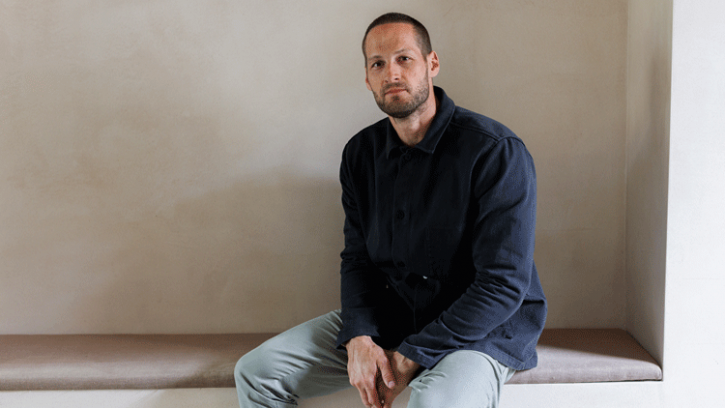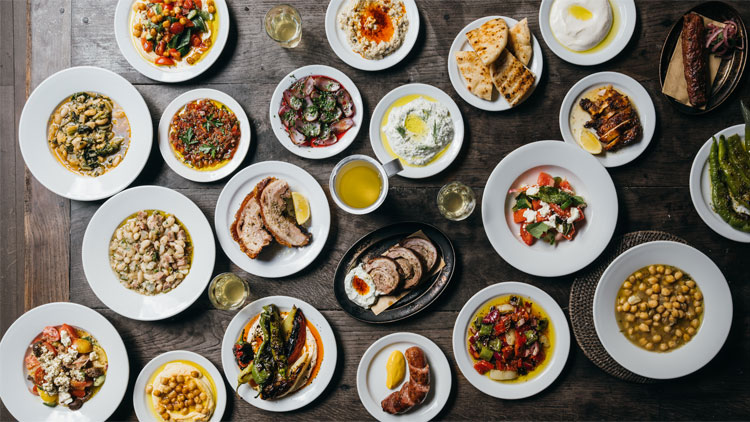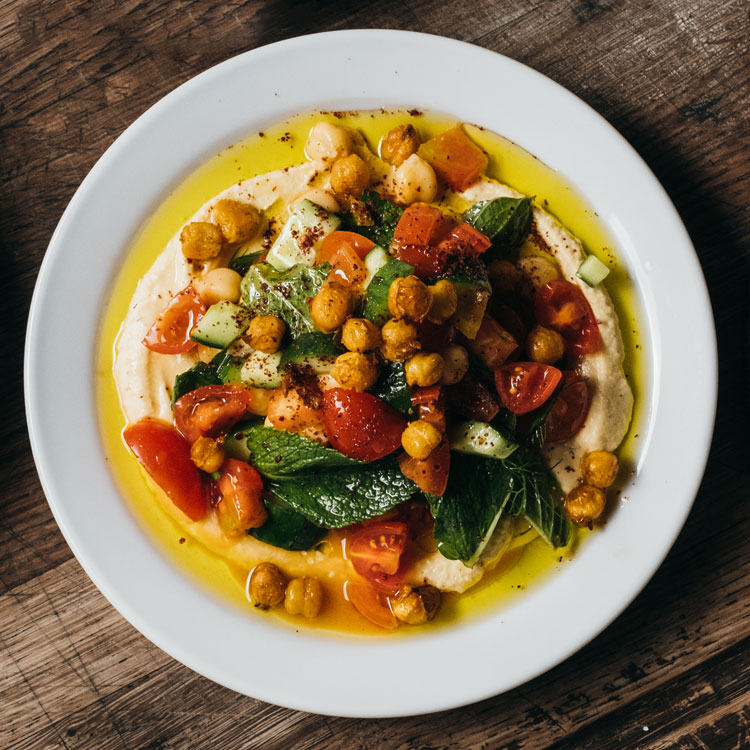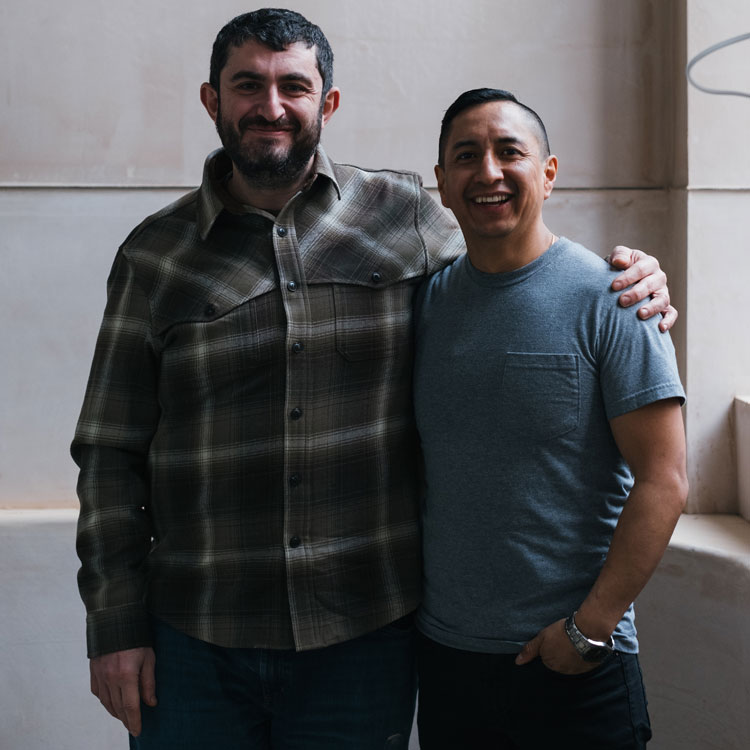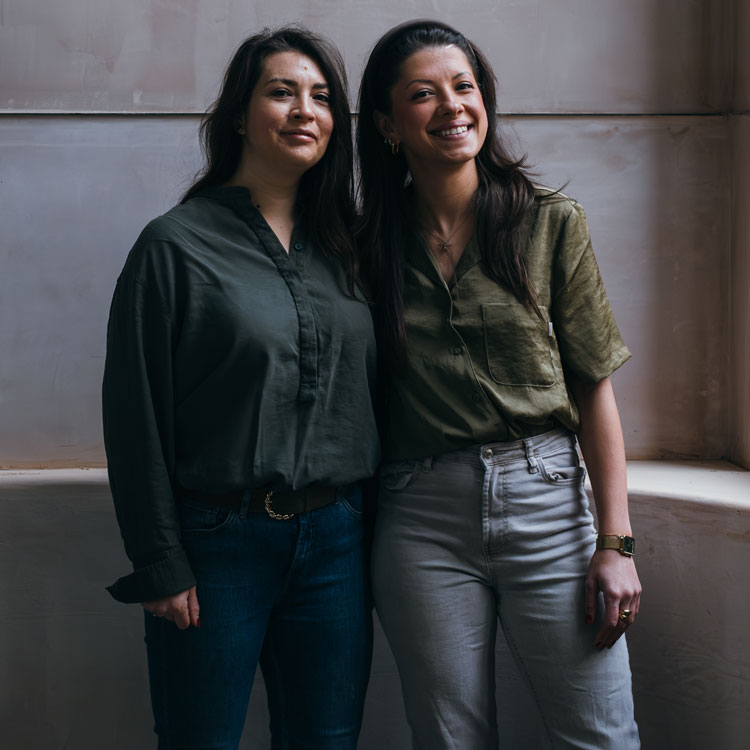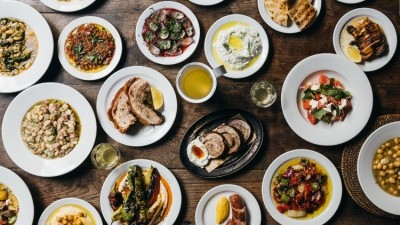Greece is the word: David Carter and team on their two-in-one Borough Market restaurant
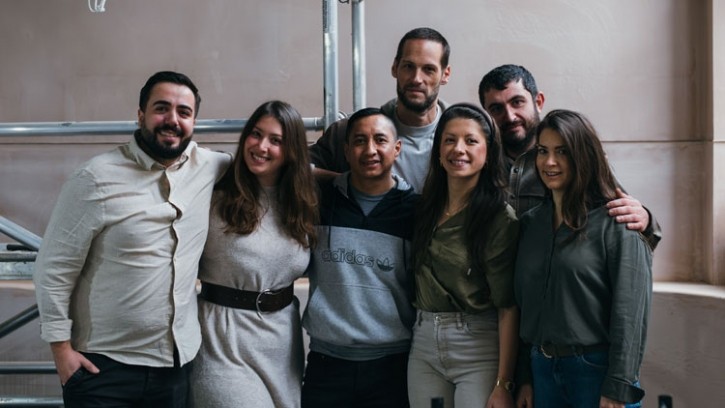
“Welcome to hell,” says David Carter as he opens the door to the building site that will soon become his largest restaurant project to date. An aspiring architect, the restaurateur behind east London hits SMOKESTAK and Manteca has been closely involved with the build and seems in his element as he ducks between ladders and extension leads with remarkable ease for a man that measures well over six foot.
In its current state the Borough Market site is not an ideal location to discuss the Greece-inspired OMA and its more informal counterpoint AGORA (the latter will hopefully open towards the end of this month while the former is set for later this spring). Blaring radios and screeching angle grinders compete with the trains rumbling in and out of London Bridge overhead. Carter’s distinctive accent – he is Barbadian – and rapid speech pattern presents a bit of an auditory challenge too.
Playing the market
Carter is right about the place being a bit of a mess. We appear to have caught 2–4 Bedale Street during a particularly chaotic phase of its construction. "We’re just about on time but we're not on budget. That's gone right down the toilet,” he says as he inspects two fresh holes that have been cut out of the ceiling in preparation for some extraction units. “This site is a unicorn. We knew we wanted it, but it was also a question of 'what the hell do we do with it?'”
Formerly Hotel Chocolat’s Rabot restaurant, the site is indeed unusual. Backing into the covered part of Borough Market itself, it has a huge frontage but doesn’t go back very far and the ground floor is a good deal smaller than the first floor. Carter’s solution is two distinct but physically and thematically linked restaurants in one.
AGORA – which will hold 55 seated covers and a further dozen or so standing - will open out right onto the street thanks to a Crittall Windows shopfront that is so large, involved and expensive it had to be ordered and partly paid for before Carter had fully secured the lease.
The more spendy OMA, meanwhile, will have a kitchen hewn from cast concrete and will seat around 70 covers inside and a further 50 or so on a semi-hidden but covetable terrace to the rear of the site that overlooks the market itself.
Make no mistake: Carter’s self-funded outfit may be small, but OMA and AGORA together make up one of the capital’s biggest launches of the year. The stakes are therefore high for Carter’s dcco. group, but as his Shoreditch venues prove he is not a man to bet against when it comes to creating zeitgeist-y restaurants that also manage to have long-term appeal.
His contemporary barbecue concept SMOKESTAK recently celebrated its 10th birthday and the sort-of Italian Manteca – which went permanent in 2021 following two successful pop-ups – remains one of the hottest tickets in town.
Carter (pictured below) looks to have once again hit the nail on the head by choosing to explore Greek food and wine. "When we launched SMOKESTAK in 2013 we were a bit late to the barbecue party,” says Carter, whose background in hospitality is largely front of house having held senior roles at Roka and Gordon Ramsay Group. “We did it because that’s what we wanted to eat, which I think is as good a reason as any to open a restaurant. It’s the same thing with Greek food for us. Over the course of many trips, I have been taken aback by the simplicity and honesty of the food.”
Getting to the Greek
The Mediterranean country’s cuisine was cited as a major growth area a few years ago having previously been largely overlooked by ambitious UK operators. Prior to this it was mostly – and wholly incorrectly - viewed as unsophisticated, but there’s a lot more to Greek food than moussaka, keftedes and the other dishes popularised by the UK’s many family-owned Greek restaurants and The Real Greek casual dining group.
In recent years Andreas Labridis and Nikos Roussos have carved out a niche with small, innovative and authentic Greek restaurants including OPSO and the more recently launched Kima and a number of luxe restaurant concepts have also set up shop, most recently Middle Eastern-import Gaia, Manchester restaurant Fenix and Richard Caring’s Bacchanalia, where the servers wear togas and sandals. But there is certainly room in the market for Carter’s take, which will be a fancy dress-free zone.
Much like Manteca – which is billed as a British restaurant cooking food with Italian sensibilities – OMA and AGORA won’t be Greek restaurants per se. “OMA and AGORA are London restaurants inspired by Greece,” Carter says. “We are not trying to replicate the food served in Greece. That is very difficult because of context – we can’t recreate the magical experience of having a Greek beer and a Greek salad on a Greek beach. Plus, we don’t want to replicate. If we wanted to just copy and paste, we would have opened 25 SMOKESTAKS and been done with it. We like to be creative.”
Fear and self-loathing in London Bridge
To aid this creativity, both OMA and AGORA will look beyond the shores of Greece to its ‘surrounding coastal regions’, namely Turkey and The Levant. As at SMOKESTAK, Carter is playing a key role in the creation of the food offer at his two new restaurants but is bringing in some heavyweight chefs in the form of former Kiln head chef Nick Molyviatis and ex-Sabor executive chef Jorge Paredes.
The Athens-born Molyviatis is a huge talent – while under his direction the Thailand-inspired Kiln was named the best restaurant in the entire country at Restaurant’s National Restaurant Awards in 2018 – but brings with him some cultural baggage.
When asked how he will bring his heritage to bear at OMA and AGORA he describes himself as a “self-loathing Greek”. Perhaps unsurprisingly given his mastery of Thai cuisine, his main issue with the food of his homeland is its restricted flavour palette.
This is where Greece’s eastern and southern neighbours come into play. Exploring these coastlines will grant the trio access to more punchy flavours – think zhoug, harissa, sumac and za’atar. “A lot of Greek cooking is simply good olive oil, lemon, oregano and salt,” Molyviatis says. “Exploring these other places will allow us to deliver the big flavours we are all fans of.”
The food offer is yet to be fully finalised. Draft menus for both concepts were created last year following an intense month or so of development and now – around four weeks out from the launch of AGORA – Carter, Molyviatis and Paredes are working on a final edit within the site that was once home to Robin Gill’s Bermondsey Larder.
Playing the market
Largely inspired by the street markets and restaurants of Athens (agora is the Greek word for market), Carter’s more casual ground floor restaurant will focus on meats – primarily pork, lamb and chicken – cooked on a two-metre charcoal rotisserie imported from Greece. Meals are intended to begin with wood-fired flatbreads served with house spreads including spinach tzatziki with crispy garlic; and strained yoghurt blitzed with feta, oregano and Aleppo chilli oil.
Hot from the wood-burning rotisserie will be a rotating selection of different cuts of meat, including rolled lamb shoulder marinated in garlic, lemon zest and oregano; and native breed pork shoulder ‘kontosouvli’ (marinated then roasted), brushed with rosemary and pork fat.
On weekends when volumes will be higher, AGORA will serve whole animals such as spit-roast lamb and native breed pork with crackling and salsa verde. Drippings from the rotisserie will flavour sides of potatoes held below, to be garnished with crispy sage. Other side dishes will include braised beans, their flavour bolstered by the bones and offcuts generated by AGORA’s slow-grilling operation.
Eventually, takeout will be offered directly from the front of the site to the hordes of people that pass by en route to the central bit of the market. It will be a key part of the AGORA experience and make the restaurant even more accessible - "I want people to smell our food before they see it,” says Carter. To this end, he plans to have AGORA’s floor-to-ceiling windows open all year round (it is hoped that a gas-fired air curtain will make this plan viable during the colder months).
Accessibility is the watchword for AGORA. It won’t take bookings, many of the tables will be communal and prices will be in line with the myriad other casual operations within Borough Market and its immediate vicinity thanks to Carter and his team’s focus on quality yet relatively affordable meat (as is the case at Manteca, taking whole animals will help) and pulses.
Carter describes AGORA as "food for the people by the people". There won’t be much on the menu for over £10 and he expects it will be less than £25 at lunch and about £40 in the evening with drinks. Drinks will be focused on cocktails – including a green chilli Margarita that Carter seems particularly excited about – and beer and wine on tap. Designed by Box 9 Design, AGORA will have an urban feel with interiors taking their cues from modern Greek colours and textures, with rendered stone walls combined with contemporary finishes in sleek steel and weathered bronze. AGORA's GM will be will be Giulia Busato.
Island hopping
While it will also take most of its culinary cues from Greece, OMA will be the yin to AGORA’s yang. “I would not say OMA is refined but it is elevated,” Carter says. “The level of the restaurant is intended to be comparable to Manteca, but in reality, the price point will be higher because the menu is focused on fish.”
Taking its name from the Greek word for raw, OMA will juxtapose a crudo bar with an open plan live fire kitchen. “The influence of the Greek islands isn’t necessarily in terms of food, it's more about the philosophy and trying to capture that beauty and rawness,” Carter says. “When we do restaurants, we look at them as a holistic package. It's about vibe and energy as much as the cooking. OMA is also an absolutely banging name for a restaurant.”
Another key difference between the two concepts is that OMA is a wine-led restaurant. Its 450-bin list is overseen by dcco.’s group wine buyer Emily Acha Derrington (see A list fit for Dionysus himself). It will have a 2am licence, with Carter intending for guests to come for the food but stick around for the wine.
Faster-paced cooking techniques
If AGORA is mostly about low and slow cooking OMA is primarily concerned with faster-paced cooking techniques. “We will take a minimal approach,” says Molyviatis. “Most of the food will be cooked on sticks. We won’t mess around. We’ll put it on, turn it a few times, and then it will be ready.”
The menu begins with plates intended for communal bread dipping including hung sheep’s yoghurt with a salt cod XO sauce; and a hummus masabacha with tahini and green zhoug. The breads served alongside these will be more involved than the simple flat breads served downstairs, including açma (a bagel-like Turkish bread), malawah (a Somalian sweet pancake), and laffa (a long-fermented flatbread that is similar in shape to a pitta).
The bread programme at both AGORA and OMA is being overseen by Eyal Schwartz, the founding head baker at E5 Bakehouse, who Carter met by chance while out researching in Greece. “He was consulting for a hotel out there. We were like ‘how can we get this guy’s bread to London?’. It turned out he was just up the road in London Fields. Bread is central to both our concepts here, so it has to be very good. We are avoiding things like sourdough and laminated breads which are already done brilliantly in London and focusing on lesser-known things.”
Raw dishes, meanwhile, will include the likes of gilthead bream with jalapeno aguachile and Datterini tomato; and yellowfin tuna with clementine and aged soy. Other pre-main event dishes include harissa-grilled prawns with cucumber and mint tzatziki, and a brown crab borek, baked until the buttery crab centre is oozy.
Reworking dishes for a London audience
There will be a Greek salad on the menu, but the dish will be indicative of the team’s approach to interpreting cuisines for a London audience in that it won’t be a conventional one. “We have to have a Greek salad, right?” says Molyviatis (pictured below with Paredes). “But it presents a challenge to a London kitchen. In Greece it is a very seasonal dish that relies on specific produce. In London we need to offer it all year round, which requires a different approach.”
“That’s absolutely right,” chips in Carter. “In Greece its vegetables, olive oil and salt. See you later. That has its place of course but we want to offer something different. Nick’s take is better than anything I have had in Greece. He salts the vegetables, makes a reduction of the water that comes out and uses that to create a dressing that we emulsify with myzithra (a ricotta-like cheese that has its origins in Crete).”
Grilled dishes will include lamb belly skewers caramelised with date molasses; butterflied red mullet with red miso butter; and Cornish squid with a garlic and za’atar oil that’s finished with a dusting of sumac. There will also be clay pots filled with hearty stews that will be kept warm on the less ferocious parts of OMA's expansive grill including a turbot collar youvetsi that is finished with a dollop of shellfish butter.
There will only be three or four desserts on at any one time including olive oil ice cream with fennel pollen and Cretan olive oil; and rizogalo rice pudding with balsamic black figs.
Again designed by Box 9 – which also worked on SMOKESTAK and Manteca – OMA will take its cues from the rugged landscapes of Greece, employing colour schemes of eucalyptus, stone and dark wood, and finishes utilising natural materials throughout. Carter intends to leave the terrace largely open for walk-ins, with the space – which is protected by the elements from roof of Borough Market itself - able to trade all year round thanks to a duo of heavy duty gas-fired heaters. OMA's GM will be David Cheles, whose CV includes SMOKESTAK and MJMK restaurant group.
Making ends meet
Powered by a large subterranean bakery and prep kitchen that both concepts will share, the project will be a big operation with a lot of moving parts when it’s fully operational. It won’t be cheap to run either – Molyviatis says that OMA will require nine to 10 chefs to run service. But Carter is no stranger to this sort of setup.
“The wage bill at Manteca is scary, too. But we use that labour to transform cheap things like flour into pasta and bread and process whole animals, which is another big saving. Our food costs are quite low. SMOKESTAK is the inverse of that in that our food costs are high, but our labour costs are low. Overall, I expect OMA and AGORA to be somewhere in between the two. It’s important to look at your cost of ingredients and cost of labour together.”
Borough Market has always been a good spot in which to run a restaurant but has taken off post-pandemic, becoming a hotspots for high-quality indies (recent launches include Camille, Kolae and Rambutan). Indeed, the launch of OMA and AGORA will mark the first time that Carter has had a truly prime site. “It will be the first place we have traded in that is actually busy,” he says. “I love the vibe in Borough Market and the wider area. It’s a little touristy, but that’s where OMA comes in. I expect upstairs to appeal mainly to Londoners.”
Surprisingly given its scale and complexity, OMA and AGORA have been organically funded by Carter’s two other places. “We spend a lot of time cradling our sites. When you do that, the rewards come,” he says. “Plus, we have never signed up to rents we can’t afford. There are a lot of variable costs in this industry and not many fixed ones. If your rents and rates are right the economics of restaurants aren’t that hard so long as you are busy and open seven days a week. Generating a decent revenue will dilute your costs.”
A take on Italian, barbecue and now a duo of Greek restaurants; what exactly is it that links dcco.’s restaurants? “I guess our focus is running quality high-volume places that we’d want to go to ourselves,” is Carter’s answer. “I want to create restaurants where you get a banging product for not too much money.”
And it looks like more of these banging establishments are soon to come from Carter and his senior team, which is all the more formidable following the arrival of Molyviatis and Paredes. “There are always things in the pipeline. We’re constantly looking at sites but for every dozen or so only one gets off the ground because they have to be right. With our funding model we can’t afford to trip up. But we always have something on the backburner.”
A list fit for Dionysus himself
SMOKESTAK and Manteca’s head of wine Emily Acha Derrington (pictured below, left) was first alerted to the project that would become OMA by her boss’s Instagram account. “There was a constant stream of images from Greek restaurants,” she says. “At the time I didn’t know much about Greek wine, and I still don’t consider myself an expert, but creating a Greek-led wine list was a very exciting prospect nonetheless.”
Acha Derrington has spent the past year or so doing a ‘deep dive’ into Greek wine. Much like Greek food, the country’s viticultural output has traditionally been underrated – criminally so, some would say – and is only now starting to be reappraised. Over the past few years wines made with grapes including Assyrtiko and the even more tricky to pronounce Xinomavro have become relatively commonplace on forward-thinking wine lists but there is much more to explore.
“There is incredible quality and value to be found, especially when it comes to lesser-known varieties. Every Mediterranean possibility is found in Greece,” says Acha Derrington, who is the partner of Manteca’s chef and co-founder Chris Leach. “The variety of terroir is amazing. There are mountains, dense pine forests, volcanic rock highlands, islands, limestone, granite. There’s as much variety as Italy, which is really saying something.”
As at Manteca, Acha Derrington will focus on wines made with indigenous grapes that haven’t been created with the international market in mind. “At most Greek tastings you come across a lot of wines that have designed to meet the criteria that produces think will get them on wine lists in, say, London and New York,” she says. “We don’t want those. We want the wines these people’s grandparents were making. We like to work with wineries that are making wines with a sense of place.”
Around 60% of OMA’s 450 bins will be sourced from Greece. In what could well be a first on these shores, the list will largely be arranged by the level of sea influence. Sections will include Surrounded by the sea (Mediterranean islands); Influenced by the sea (much of Greece as well as parts of France, Spain, Portugal and even England itself); and Further inland (wines that are not so much influenced by the sea).
“We’re not going to ignore places like Burgundy and Piedmont. But the wine list is led by the influence of water,” says Acha Derrington, who started buying for OMA around a year ago squirreling wines away under Manteca’s banquettes. “It’s taken a lot of planning, some of these wines are very difficult to get hold of. A lot of the islands stuff is low-intervention, but a lot of the other stuff is not. My wine palate in general is more classic.”
Heading up wine service at OMA will be Alessandara Tasca, who is currently a sommelier at Manteca and has a CV that includes natural wine importer Modal Wines and a stint with chef restaurateur Robin Gill.
